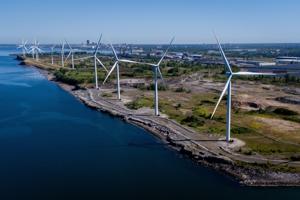New York’s Renewable Energy Goals Challenged by Rising Demand

New York Governor Kathy Hochul is reassessing the state’s ambitious renewable energy targets established under the previous administration. The revised approach comes as New York grapples with a surge in electricity demand driven by data centers, expanding manufacturing, and the growing prevalence of electric vehicles. This demand could increase by 50% to 90% over the next two decades, presenting significant challenges to the state’s energy landscape.
The state’s current renewable energy production is not keeping pace with the anticipated demand. As fossil fuel-based power generation declines at twice the rate of new renewable energy sources coming online, the New York Independent System Operator (NYISO) has raised concerns about the reliability of electricity supply. In May, the NYISO suggested that the state may need to reactivate certain natural gas-fired power plants to bridge the gap.
In response to these challenges, Hochul has directed the New York Power Authority and the Department of Public Service to explore options for establishing a new nuclear energy plant in upstate New York. This proposal includes plans for facilities capable of generating up to 1 gigawatt of electricity, aimed at addressing the rising demand. Critics of this approach argue that increasing reliance on nuclear energy may not be the appropriate direction.
Amid rising costs, energy bills have become a pressing concern for consumers. National Grid is pursuing a 15% rate hike, while New York State Electric & Gas implemented a rate increase last year that will raise the average customer’s bill by 31% over three years. As affordability becomes a central issue, the state’s energy plan, which outlines goals through 2040, acknowledges the difficulties New York faces in meeting its climate objectives while ensuring a reliable energy system.
The draft energy plan emphasizes that while traditional fuels will continue to play a significant role, the contribution from clean and renewable sources must increase. The NYISO has indicated that more renewable energy capacity is essential, alongside maintaining natural gas as part of the energy mix. The plan asserts that investment in natural gas infrastructure is necessary to meet demand, especially during extreme weather conditions.
Environmental advocates urge the Hochul administration to recommit to its climate goals. Liz Moran, New York policy advocate for Earthjustice, expressed concern that the governor appears to be sidestepping the state’s climate mandates. These include a requirement to cut greenhouse gas emissions by 40% by 2030 and to generate 70% of the state’s electricity from renewable sources.
The energy plan suggests that New York may not achieve its renewable electricity target until 2033, three years later than initially projected. The NYISO has highlighted the need for faster integration of renewable resources, emphasizing that wind and solar energy production often operates at lower capacity due to dependency on weather conditions. Additionally, the NYISO’s recommendations include considering updates to aging fossil fuel facilities to enhance capacity and efficiency.
Environmental groups have challenged the NYISO’s recent report, arguing that it misrepresents the necessity for additional fossil fuel generation. Moran pointed out the need to focus on renewable energy to power homes and businesses, calling for an urgent shift in prioritization.
The NYISO maintains that its report reflects recent improvements in the interconnection process, which could facilitate the deployment of renewable energy projects. Yet, Moran emphasized that the state should expedite the transition away from natural gas due to both emissions concerns and financial implications.
As New York lawmakers approach the April 1, 2024, budget deadline, negotiations are underway to establish a comprehensive climate and energy strategy. The outcome will have significant implications for the state’s economy and the daily lives of millions of residents.
In recent developments, Hochul has introduced a plan to expand nuclear power capacity at an unspecified location in upstate New York. While there are existing nuclear facilities in the state, no new capacity has been added for decades. Questions remain about the timeline for constructing such a facility and its potential to contribute to New York’s energy supply.
The ongoing energy debate is further complicated by public sentiment regarding affordability and the complex landscape of energy use in homes and buildings. With the state’s future energy strategy in flux, the focus on balancing renewable energy deployment with reliability and cost will be critical in shaping New York’s energy future.






